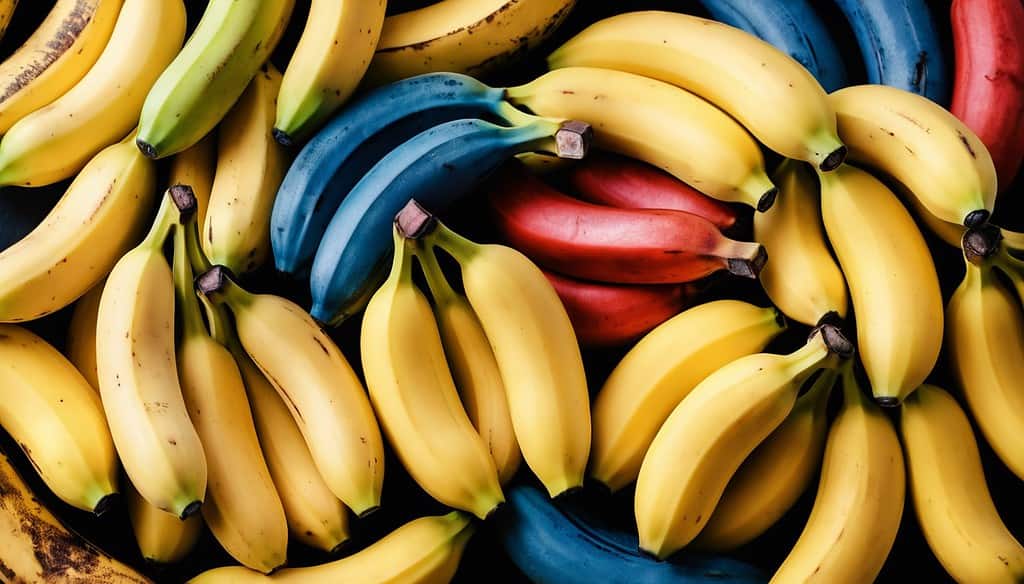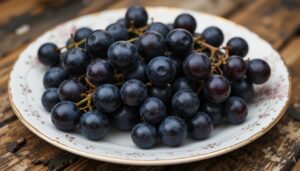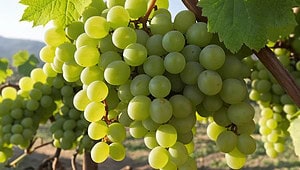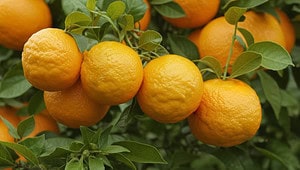Table of Contents
Musaceae Fruits: Savory and Wholesome

Musaceae fruits, belonging to the family Musaceae, are one of the most well-known and widely consumed fruit families around the world. This family includes the banana and plantain, both staples in many diets, known for their versatility, nutritional benefits, and distinct flavors. These fruits thrive in tropical and subtropical climates, making them abundant in regions like Southeast Asia, Africa, and Central America. The banana, in particular, has gained international recognition, not just as a savory and wholesome snack but also as a key ingredient in smoothies, desserts, and various savory dishes. Plantains, which are often mistaken for bananas, are a type of Musaceae fruit typically cooked before consumption, offering a slightly firmer texture and a more savory flavor profile.
The diversity of Musaceae fruits goes beyond the familiar banana and plantain. Less common varieties like the red banana and the blue java banana add variety to the spectrum of flavors and textures, each contributing to the rich cultural tapestry of tropical cuisines. The benefits of Musaceae fruits extend beyond their taste and culinary uses. Packed with essential nutrients like potassium, vitamin C, and dietary fiber, these Musaceae fruits are not only a delicious addition to meals but also provide numerous health advantages. They are known to support heart health, aid in digestion, and boost energy levels, making them a natural and sustainable food source.
In addition to their health benefits, Musaceae fruits play a significant role in the economies of many tropical nations. Their cultivation and export provide livelihoods for millions of people, contributing to the local agricultural sectors and global trade. As the demand for Musaceae fruits continues to grow, innovations in farming and distribution methods ensure that these fruits remain accessible to a global audience. From their diverse uses in cooking to their rich nutritional profile, Musaceae fruits are much more than just a popular snack—they are an essential part of both local and global food systems.
In this article, we are going to talk about 8 of the most important and popular Musaceae fruits.
1. Musaceae Fruits: Banana

The banana is one of the most widely recognized Musaceae fruits, enjoyed around the world for its sweetness, convenience, and versatility. This fruit is typically elongated with a yellow peel that turns brown when overripe. Bananas are predominantly cultivated in tropical and subtropical areas, establishing them as a fundamental food item in numerous households around the world. As one of the most commercially significant Musaceae fruits, bananas are grown in large quantities to meet global demand.
Bananas are an excellent source of essential nutrients, particularly potassium, vitamin C, and dietary fiber. Potassium is crucial for maintaining healthy blood pressure and proper muscle and nerve function, while vitamin C supports the immune system and helps the body absorb iron. The fiber found in bananas aids digestion and promotes gut health, making the fruit a natural choice for people looking to maintain a balanced diet.
Culinary uses for bananas are endless, making them a versatile ingredient in both sweet and savory dishes. In many cultures, bananas are consumed raw as a quick snack or used to prepare smoothies, desserts, and baked goods such as banana bread. They can also be fried or grilled in some regions, where they are served as a side dish with meats or rice. Additionally, bananas are often dried and used as a snack or added to cereals and granola bars. The fruit’s popularity is not limited to just the food industry; bananas are also used in cosmetics, where banana extracts are found in moisturizers and hair care products.
Due to their widespread cultivation and consumption, bananas are also a key economic driver in many tropical countries. They are one of the primary exports of nations like India, the Philippines, and Ecuador, where millions of people rely on banana farming for their livelihood. The high demand for bananas has spurred innovations in agricultural practices and distribution networks, ensuring that this beloved Musaceae fruit remains accessible to people around the globe.
2. Musaceae Fruits: Plantain

The plantain is a close relative of the banana and one of the most important Musaceae fruits in many tropical and subtropical regions. Plantains are generally larger than bananas, possess a thicker skin, and contain a higher starch content, making them less sweet. Plantains are not typically eaten raw, as their flesh remains firm and somewhat bland until cooked. They are an essential ingredient in a wide variety of dishes, especially in countries throughout Africa, Latin America, and the Caribbean.
In terms of nutrition, plantains are an excellent source of complex carbohydrates and dietary fiber. They provide a steady release of energy, making them an ideal food for people who need long-lasting fuel throughout the day. Plantains are also rich in vitamins A, C, and B6, as well as potassium and magnesium. Vitamin A contributes to the maintenance of eye health, whereas vitamin C enhances the immune system’s functionality. B6 is essential for brain function and the production of red blood cells. The combination of nutrients makes plantains a healthful addition to any diet.
Plantains are incredibly versatile in the kitchen. They can be boiled, fried, baked, or grilled, depending on the desired dish. In West Africa, boiled plantains are often served alongside stews and soups, while fried plantains, known as “patacones” or “tostones” in Latin America, are a popular side dish or snack. In the Caribbean, plantains are commonly included in savory dishes such as curries or casseroles. In addition to these savory uses, plantains are sometimes incorporated into sweet dishes like plantain fritters or plantain-based desserts.
The economic and cultural importance of plantains cannot be overstated. Plantains serve as a fundamental food source in numerous nations, offering a dependable means of nourishment to millions of individuals. They are often used in food security programs, particularly in regions prone to food shortages, due to their resilience in growth and storage. As one of the most cultivated Musaceae fruits, plantains play a significant role in local economies and agricultural practices.
3. Musaceae Fruits: Red Banana

The red banana, a lesser-known but distinctive variety of the Musaceae family, is another fascinating fruit that offers a unique twist on the familiar banana. Red bananas are smaller and shorter than the standard yellow banana, with a reddish-purple peel that darkens as the fruit ripens. The flesh of the red banana is typically creamier and sweeter than its yellow counterpart, with hints of raspberry or strawberry flavor, depending on the variety. This makes red bananas a desirable option for people who enjoy a more complex taste profile in their fruits.
Red bananas are nutritionally similar to yellow bananas, offering a good amount of potassium, vitamin C, and fiber. However, they have a slightly higher sugar content, which makes them a bit sweeter. The increased sugar content, combined with their natural flavor profile, makes red bananas a perfect choice for use in desserts, smoothies, or as a sweet snack. In some cultures, red bananas are eaten raw, but they can also be cooked in a similar manner to plantains, adding a touch of sweetness to savory dishes.
Beyond their taste and appearance, red bananas offer a number of health benefits. The increased antioxidant content in red bananas, particularly anthocyanins, which give the fruit its reddish color, can help reduce inflammation and protect the body from oxidative stress. These antioxidants are known to support heart health by reducing the risk of cardiovascular diseases and improving blood circulation. Red bananas are also believed to aid in digestion, as they contain both soluble and insoluble fiber, which promote healthy bowel movements and prevent constipation.
Despite being less common than yellow bananas, red bananas are becoming increasingly popular in health-conscious markets due to their nutritional value and exotic appeal. They are often sold in specialty stores, where their distinctive color and taste attract consumers looking for something new and different. The growing popularity of red bananas has led to increased cultivation and distribution, especially in tropical regions where they thrive. As a unique and healthful variant of Musaceae fruits, red bananas have carved out a niche for themselves in the global fruit market.
4. Musaceae Fruits: Blue Java Banana

The Blue Java banana is one of the most intriguing varieties of Musaceae fruits, known for its striking appearance and unique flavor. Also referred to as the “ice cream banana” due to its blue-gray skin and creamy, vanilla-like taste, this variety has become a sought-after fruit for people who enjoy novel and exotic options. Blue Java bananas are typically smaller than regular bananas and have a silvery-blue peel that changes to a light silver or pale blue hue as they ripen. The flesh inside is pale and soft, with a texture that is remarkably similar to ice cream, making it an ideal ingredient for making dairy-free banana-based desserts.
Nutritionally, Blue Java bananas are similar to other types of bananas. They provide a good source of potassium, which helps regulate blood pressure and supports muscle and nerve function. Additionally, they contain vitamin C, which strengthens the immune system and promotes skin health, as well as dietary fiber, which supports digestion. However, Blue Java bananas are often considered more nutrient-dense than regular bananas due to their higher content of antioxidants, which contribute to their unique flavor and texture.
In terms of culinary applications, Blue Java bananas are best known for their use in smoothies and desserts. Their creamy texture and subtle vanilla flavor make them an excellent base for making plant-based ice cream, shakes, or other frozen treats. They can also be blended into smoothies or eaten raw as a sweet snack. In some regions, Blue Java bananas are used in baked goods or even frozen and served as a refreshing treat in hot climates.
The growing demand for Blue Java bananas in health food markets and among food enthusiasts has led to an increase in their cultivation. While they are still relatively rare compared to more common banana varieties, their unique flavor and appearance have contributed to their popularity in specialty markets. Blue Java bananas are a prime example of how Musaceae fruits can evolve and adapt, offering a distinct alternative to the traditional banana while providing the same health benefits and versatility.
5. Musaceae Fruits: Apple Banana/ Manzano Banana

The apple banana, commonly referred to as the “manzano banana,” is a small and sweet variety of fruit belonging to the Musaceae family, notable for its unique flavor profile. Often referred to as the “apple banana” due to its flavor profile, it offers a delightful mix of banana sweetness with a hint of apple-like tartness. This variety is popular in many tropical regions, particularly in Central and South America, and is also gaining attention in other parts of the world due to its unique taste and texture.
Apple bananas are smaller and thicker than the regular yellow banana, with a slightly firmer texture when ripe. Their skin is typically yellow when ripe, with a slight pinkish tint. The flesh is dense and slightly tangy, which differentiates it from the more commonly consumed varieties of Musaceae fruits. This makes them ideal for those seeking a richer flavor or a slightly different experience than the usual banana. As a result, they are often eaten raw as a snack or used in smoothies, fruit salads, and other dessert applications.
In terms of nutrition, apple bananas provide an impressive array of health benefits, much like other Musaceae fruits. They are rich in potassium, which helps maintain heart health by regulating blood pressure. Additionally, they offer a good source of vitamin C, an essential nutrient that boosts immunity and supports collagen production for healthy skin. Apple bananas are also packed with dietary fiber, aiding in digestion and supporting gut health. Furthermore, the fiber in these fruits contributes to a feeling of fullness, making them a great option for weight management.
Culinary-wise, apple bananas are highly versatile. Beyond being enjoyed fresh, they can be used in various dishes, including banana bread, pancakes, and muffins, where their slightly tangy flavor complements baked goods. They are also a popular ingredient in tropical smoothies, where their sweetness and texture add a delightful creaminess. The apple banana’s ability to hold its shape when cooked also makes it suitable for use in dishes such as fritters or desserts like banana foster.
As one of the more exotic types of Musaceae fruits, the apple banana is gradually becoming more widely available in international markets. Its appeal lies not only in its unique flavor but also in its nutritional benefits, making it a favorite for health-conscious consumers. As the demand for diverse varieties of bananas grows, apple bananas are likely to gain even more popularity in the coming years.
6. Musaceae Fruits: Cavendish Banana

The Cavendish banana is by far the most widely recognized and cultivated of all Musaceae fruits. This variety has become the global standard for bananas, occupying a dominant position in the international fruit market. Most of the bananas you find in grocery stores worldwide are Cavendish bananas, named after the British horticulturist William Cavendish, who played a key role in their development. This banana variety is characterized by its elongated shape, bright yellow peel, and sweet, mild flavor.
Cavendish bananas are typically harvested while they are still green and ripen as they are transported to markets around the world. Their popularity can be attributed to their consistency in flavor, texture, and size, which makes them ideal for large-scale production and distribution. These bananas are commonly used in a variety of ways, from being eaten raw as a snack to being included in desserts, smoothies, and breakfast dishes like cereal or oatmeal.
From a nutritional standpoint, Cavendish bananas offer the same health benefits as other Musaceae fruits. They are an excellent source of potassium, which helps maintain proper muscle and nerve function, as well as vitamin B6, which plays a key role in energy metabolism. Additionally, Cavendish bananas are rich in fiber, which promotes digestive health and can help regulate blood sugar levels. The fruit also contains moderate amounts of vitamin C, which supports immune function and aids in the absorption of iron from plant-based foods.
Despite being one of the most widely consumed Musaceae fruits, Cavendish bananas face significant challenges. One of the most pressing issues is the threat posed by a soil-borne fungus called Fusarium wilt, which has devastated banana plantations worldwide. The Cavendish variety, being genetically uniform, is particularly vulnerable to this disease. As a result, there are ongoing efforts to develop new banana cultivars that are resistant to Fusarium wilt and other environmental threats. This underscores the vulnerability of monoculture agriculture and emphasizes the significance of diversity in banana farming.
Cavendish bananas are also an essential crop in many tropical and subtropical regions, where their cultivation supports local economies and provides jobs for millions of people. Although they dominate the market, there is growing interest in exploring other banana varieties, such as red bananas or plantains, in order to diversify banana production and reduce the risks associated with over-reliance on a single cultivar.
7. Musaceae Fruits: Pisang Raja

Pisang Raja is a beloved variety of Musaceae fruit that is particularly popular in Southeast Asia. Known for its distinctive sweetness and rich, soft texture, Pisang Raja is often considered one of the best-tasting banana varieties in the world. This variety has a thicker skin compared to the standard Cavendish banana and is typically longer, with a slightly curved shape. The peel is bright yellow when ripe, and the flesh inside is sweet and creamy, making it a favorite for fresh consumption.
Unlike other types of bananas, Pisang Raja bananas are often not eaten raw when they are fully ripe. Instead, they are usually cooked, whether boiled, fried, or used in desserts. In many parts of Southeast Asia, Pisang Raja bananas are used in traditional recipes such as banana fritters, where they are coated in batter and deep-fried to create a crispy, sweet treat. They are also commonly added to desserts like “kolak,” a traditional Indonesian dish made with bananas, coconut milk, and palm sugar.
Nutritionally, Pisang Raja bananas share many of the same health benefits as other Musaceae fruits. They are rich in potassium, which helps regulate blood pressure, and are also a good source of vitamin C and vitamin B6. These nutrients support immune health, improve skin quality, and promote proper brain function. Pisang Raja bananas also contain a substantial amount of dietary fiber, which aids digestion and helps maintain a healthy gut.
In addition to their nutritional value, Pisang Raja bananas hold significant cultural importance in Southeast Asia. They are frequently used in ceremonial and festive dishes, and their presence in local markets is a symbol of abundance and prosperity. The popularity of Pisang Raja has led to increased cultivation, and it is now being grown in several tropical countries outside of Southeast Asia, though it remains most commonly associated with Indonesia and Malaysia.
As a highly prized and versatile fruit, Pisang Raja bananas are not only valued for their taste and texture but also for their role in sustaining local economies. The cultivation of Pisang Raja provides jobs for farmers and plays a significant role in the agricultural landscape of Southeast Asia. The growing global interest in diverse banana varieties has further enhanced the prominence of Pisang Raja on the international stage.
8. Musaceae Fruits: Baby Banana / Lady Finger Banana

The baby banana, often referred to as the “ladyfinger banana” due to its petite size and delicate flavor, is another delightful variety of Musaceae fruit that stands out for its sweetness and ease of consumption. Typically smaller than the average banana, baby bananas are only about half the size of regular Cavendish bananas, making them perfect for snacking. Their peel is thin and bright yellow when ripe, and the flesh inside is sweet, soft, and creamy, offering a delightful bite-sized treat.
Baby bananas are rich in the same nutrients as other Musaceae fruits, providing a good amount of potassium, vitamin C, and dietary fiber. Potassium is important for maintaining proper heart and muscle function, while vitamin C boosts the immune system and supports healthy skin. The fiber content in baby bananas promotes healthy digestion and helps regulate bowel movements. Although baby bananas are smaller in size, their high sugar content makes them a naturally sweet and energy-boosting snack.
These small bananas are commonly eaten fresh, either as a snack or added to fruit salads and smoothies. Due to their natural sweetness, baby bananas are also a popular ingredient in desserts such as banana cakes, muffins, and puddings. Their size and texture make them ideal for use in baby food, as they are easy to mash and digest, which is why they are often recommended as a first fruit for infants.
The small size and unique flavor of baby bananas have contributed to their growing popularity outside of tropical regions, with many grocery stores and supermarkets now offering them as a specialty fruit. They are increasingly available in markets worldwide, providing consumers with a fun, healthy alternative to the more traditional banana varieties. As the demand for unique and exotic Musaceae fruits continues to rise, baby bananas are likely to maintain their appeal, offering both health benefits and culinary flexibility.
Disclaimers: *This article is only for informational purposes.
**Do not make your important decisions based solely on the information provided in this article. Do your own research.
***Information in this article may vary or may get updated in the future.
****Contact a doctor or a medical professional for any medical emergency.
Read More Science and Space Articles
- 8 Incredible Vitaceae Fruits: Nature’s Tasty Treasures
- 8 Incredible Rosaceae Fruits You Need to Discover
- 8 Amazing Citrus Fruits That Will Brighten Your Day
- 8 Non-CO₂ Greenhouse Gasses That Are Worst Than CO₂
- Chemistry: 8 Unique Ways to Become Efficient At It
- 8 Ways Water Crisis is Worsened by Global Climate Change
- 8 Amazing Ways Brain Anatomy is Altered by New Learning
- 8 Disastrous Ways Deforestation Destroys Biodiversity
- Mathematics: 8 Interesting Ways To Become Efficient At It
- 8 Worst Ways Global Climate Change Hurts The Impoverished
- Danger Of Environmental Damage: 8 Ways A Person Can Help
- Eradication Of Poverty: 8 Critical Ways Science Helps
- STEM Fields: 8 Important Reasons Why You Must Learn Them
- Making Your Kid Efficient At STEM Subjects: 8 Important Steps
- Making Your Kid Science Enthusiast: 8 Important Steps
- Becoming A NASA Aspirant: 8 Important Steps You Must Follow
- Top 8 Important Wellness Habits That You Must Follow
- Top 5 Amazing Whole Grains That Are Healthier Than Rice
- Indian Space Program: 8 Incredible Achievements
- China’s Space Program: 5 Amazing Accomplishments
- Discoveries by JWST: 10 Incredible Findings of The Telescope
- NASA’s MOXIE Creates O2: Big Step Towards Mars Colonization
- Top 5 Amazing Properties of Time That Defy Common Sense
- 10 Factors for Emergence of Intelligent Life in The Universe
- Space Science: 6 Vital Reasons Why We Should Invest in It
- Solar System: 10 Astonishing Uniqueness of our star system
- Our Universe: An Incredible Journey of 13.7 Billion Years
- Top 6 Solar System Objects That Might Destroy Life On Earth
- Certain End of The Universe: 4 Forces of Nature to Watch Out For
- Big Bang: An Incredible Start of Universe 14 Billion Years Ago




